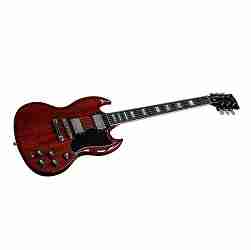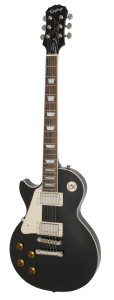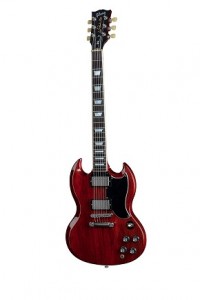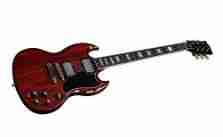Some links on this page are monetized by affiliate programs – see disclosure for details.
 Buying a new electric guitar is an exhilarating experience. First, it is important to understand that there are many factors involved and many brands and models from which to choose.
Buying a new electric guitar is an exhilarating experience. First, it is important to understand that there are many factors involved and many brands and models from which to choose.
Passion and ambition for music is essentially linked to the instrument you choose to play. So, before we begin walking through our selections for the “best” beginner, intermediate, and advanced guitars, let it be known that we undertake an impossible task–for the love one has for an instrument and the talent it enables are the only true measures of its quality.
The History of the Electric Guitar
Contents
The electric guitar is an essential artifact of the American and British rock traditions, but it has also lent its power to the development of jazz, blues, and countless experimental projects.
The earliest iterations of guitar reach back to the 12th century, but electric models were introduced in the early 1930s, enabling a whole new range of sound.
The Electric Guitar and its Anatomy
A guitar is a stringed instrument that may include between four to 18 strings with a long fretted neck on which to run, a larger body with curved sides, and a sound that is dependent upon the vibration and resonance of said strings through a solid material or electrical current.
An electric guitar is a guitar whose sound is amplified by pickups.
Pickups
Pickups convert the vibration of a plucked guitar string into an electrical impulse that is then communicated to an amplifier. Often come with single electrical coils, but others may have dual coils.
Amps
The sound that is produced by an electric guitar requires amplification through the aptly named, “amplifier”, before it is then transferred to a speaker or speaker system.
Wood
Common woods used to construct guitars include mahogany, cedar, alder, basswood, swamp ash, walnut, spruce, and rosewood. A mahogany guitar is generally going to be heavier and will convey a rich, deep, syrupy sound, whereas a maple guitar will be lighter in weight, and will produce bright, sunny sounds that may feature a little more bite when played.
Body
The body of a guitar is the largest piece and is generally made out of one solid piece of wood. Here, comfort is essential. It is imperative that the body of a guitar rests comfortably either against the groin while standing or on the thighs while sitting. The bottom half of the body should feature an output jack, control knobs for volume, bass, and treble, and a bridge to lock the strings into place.
Neck
The neck extends out of the body and serves as the foundation of the fret board and strings. The neck is often made of a different type of wood than the body; two types of wood are often combined to achieve a distinct sound. Since a great deal of a player’s action will require movement up and down the neck, it is important to test how smoothly a hand can move along it or grasp it.
Fret Board
The fret board, or finger board, is a long piece of wood that is attached to the topside of the neck. To play an instrument with a fret board, the player will depress strings against the fret board to produce different notes or chords.
Head Stock
The head stock is the piece that houses the tuning components. These components include tuning pegs and a small bridge that allow the tension of the strings to be adjusted to modify the pitch of the strings.
Best Guitars by Level
Beginner: Squier BulletStrat, by Fender
Intermediate: Les Paul Standard, by Epiphone
Advanced: SG Standard, by Gibson
What to Look For
Factors such as build quality, intonation, scale length and action, and overall comfort should be examined objectively to make the best decision possible. You may be struck by a guitar that looks beautiful, but if it doesn’t feel right in your hands, then it probably isn’t the one for you.
Below, we will offer an objective experienced-based review on our selected guitars to help you choose the right one for you.
Build Quality of Components
Squier BulletStrat by Fender
The BulletStrat has been around since 1954. Today, it remains a solidly built guitar, in part due to its age.
The BulletStrat is made of basswood, which is a more cost effective alternative to Alder or Maple. Purists may flinch at this, but the basswood plays just fine. The beginner guitarist would likely never hear a difference in sound quality.
The signature shape of the body has changed very little over time. The curves in the body may have deepened some since 1954, but we actually found this to make manipulating the guitar a bit easier.
The size of the neck has remain unchanged and is still one of the smaller ones found on market models. The neck can be gripped with surety and also used with dexterity.
Overall, the BulletStrat is not the most perfect production of a guitar, but for a beginner, it holds tremendous value.
Les Paul Standard by Epiphone
The Epiphone Les Paul is wonderfully produced and maintains nearly every aspect of the original’s design in a package that is perfect for the intermediate player.
The body is made of solid mahogany and has a maple top, mahogany neck, and a rosewood fingerboard. The combination of heavier woods makes for a gorgeous thick sound that is dripping with detail.
The classic, two-coil dual humbuckers are included here, true to the classic Les Paul design. The dual coils convey an enormous amount of detail and produce a clear and bright sound.
From the glossy, polished wood of the body, to the detailed mother of pearl ornamentation, this is a truly beautiful guitar.
SG Standard, by Gibson
Since its creation in 1961, the Gibson SG has become Gibson’s top selling electric guitar. It is clear that the success of the model is due to its excellent design and exacting production.
The 2015 SG Standard model adds a more stable neck joint to the 1960s models which were once prone to breakage. The classic humbuckers allow for incredibly warm and precise detail throughout periods of sweet sustain or crunchy distortion.
The SG comes with a mahogany body and a rosewood fret board that has been widened.
For the 2015 model, Gibson has added their Min-Etune System. This is a proprietary automatic tuning device attached to the underside of the headstock–when a setting is dialed, the tuning pins will mechanically adjust to the proper tuning. In testing, the tuner worked very well and actually cut down on time considerably.
The SG is a beautifully assembled guitar.
Intonation
Squier BulletStrat by Fender
The BulletStrat performed admirably during testing, but not perfectly. Around the 12th fret, our ears and tuners detected some distortion in the notes. This is to be expected on an entry-level guitar.
The sound quality of the BulletStrat is very good given the price tag.
Les Paul Standard by Epiphone
The intonation of the Les Paul was very accurate. Only in the higher notes was there any distortion.
Overall, the accuracy of LP intonation reflects strong craftsmanship and a precisely produced instrument from Epiphone.
SG Standard nby Gibson
The SG Standard played without indication of misalignment.
The SG sounds incredible because of its quality components and construction. The high price tag that comes with many Gibson guitars is largely due to their top-of-the-line production.
Scale Length and Action
Squier BulletStrat by Fender
We found the BulletStrat to be 25.3 inches—nearly the standard for Fender electrics.
We were not entirely surprised given that this is a widely produced model and errors do sometimes occur.
The 25.5 inch scale length contributes to the BulletStrat’s cutting tone.
The BulletStrat action is very low, suitable to a fast playstyle and also making the depression of strings a little less difficult.
Les Paul Standard, by Epiphone
The Les Paul came in at 24.75 inches in length, contributing to its more rounded sound.
This is the exact standard of the brand and is a reflection of the guitar’s overall fine build quality.
The LP has a mid-level action characteristic of the brand. This requires a player to exert a bit more effort to depress strings.
SG Standard, by Gibson
The SG measured in at the manufacturer standard of 24.75 inches in length. This precision reflects build quality.
The SG has an action that is a bit higher than the BulletStrat, but a bit lower than the Epiphone, providing a nice balance between speed and precision.
Physical and Aesthetic Comfort
Squier BulletStrat by Fender
The classic Stratocaster design makes for a comfortable guitar. Deep cuts in the top and bottom of the body allow for comfortable positioning for any player.
This model is ideal for beginners partly because the guitar is lightweight and easy to handle. As a new player, comfort is paramount as one will (hopefully) be dedicating a tremendous amount of time to learning the instrument and the basics of technique.
Some reports indicate that this model has sharp frets. We didn’t notice anything during our testing session, but you certainly know that they’re there. If you are overly concerned with this, the frets can always be blunted with some careful work.
The BulletStrat is a simple model with very little ornamentation. For some, that is a point of value. Generally speaking, the greater amount of detail and ornamentation a guitar has, the higher its price tag will be.
For the beginner, function ought to matter above all else, and the BulletStrat is a very comfortable and lightweight guitar that anyone can practice on for hours.
Les Paul Standard by Epiphone
The Epiphone Les Paul is a guitar that will stun with its looks and may create some fatigue during play.
The guitar is heavy. The mahogany build is responsible for this, but the choice of wood and its quality is also what provides it with a beautiful and distinct sound.
The top curve of the body provides a nice place to rest one’s playing arm, but the rounded end of the body is a little less assuring, creating the feeling that one’s arm might slip on the polished wood and fall off into space.
There is so much love and nostalgia associated with the LP style that little has been done to provide updates, and that is mainly a good thing. Customers want a model that is true to the original.
Epiphone has done a fine job of creating a guitar that both looks and sounds beautiful, even if it isn’t the most comfortable to play over long sessions.
SG Standard by Gibson
Unlike many older models, the original design of the SG was actually way ahead of its time, making it an electric that is very comfortable and fast to play.
The first thing you might notice about the SG is just how light it is. Weighing in at just over four pounds, the SG can be wielded with ease. Its lighter weight is due to the fact that the SG retains its original slim-profile and is nowhere near as beefy as a Les Paul model.
It is true that the sound produced by a smaller body instrument is generally going to pack a little less punch than a larger counterpart. Nonetheless, the SG manages to both look and sound phenomenal.
The widened rosewood fretboard provides more room to play and an incredibly smooth surface to play on.
The overall body design is classic, and for most people, the top and bottom cutaways will suit any play style.
Our Electric Guitar Reviews
Best Beginner Electric Guitar – Squier BulletStrat, by Fender
 Fender has been making guitars since 1946, and this is reflected in the wonderful quality of their builds. The BulletStrat is a guitar with a slim body profile and a biting and classic tone.
Fender has been making guitars since 1946, and this is reflected in the wonderful quality of their builds. The BulletStrat is a guitar with a slim body profile and a biting and classic tone.
This is a fantastic entry-level instrument for the budding guitarist.
Best Intermediate Electric Guitar Guitar – Les Paul Standard by Epiphone
 Not to be confused with the far more expensive, Gibson Les Paul, Epiphone’s version is a beautiful rendition on the classic and beloved model.
Not to be confused with the far more expensive, Gibson Les Paul, Epiphone’s version is a beautiful rendition on the classic and beloved model.
A fantastic step up from an entry-level electric, it carries a tone that is bright and clean. Its signature humbucker pickups perform beautifully and the body’s detailed ornamentation make it an ideal model for the intermediate player.
Best Professional Electric Guitar SG Standard by Gibson
 Created in 1961, the Gibson SG is a truly fine guitar with a long and diverse history. Sporting a solid mahogany body and beautiful Gibson construction, the SG is a truly premium guitar that performs wonderfully.
Created in 1961, the Gibson SG is a truly fine guitar with a long and diverse history. Sporting a solid mahogany body and beautiful Gibson construction, the SG is a truly premium guitar that performs wonderfully.
This year’s Gibson Min-Etune system make it an excellent investment for the advanced enthusiast or professional.
The Bottom Line
Whether you have been playing for years and know, or are just looking to start and will learn, playing the guitar is a life-long reward. Choosing the right electric guitar can be very challenging given that there are countless options and learning the nuances of an instrument hardware can take years.
If you equip yourself with the right knowledge and look out for the model that feels the best to you, then you will likely make a decision that will keep you playing happily for many years to come.
